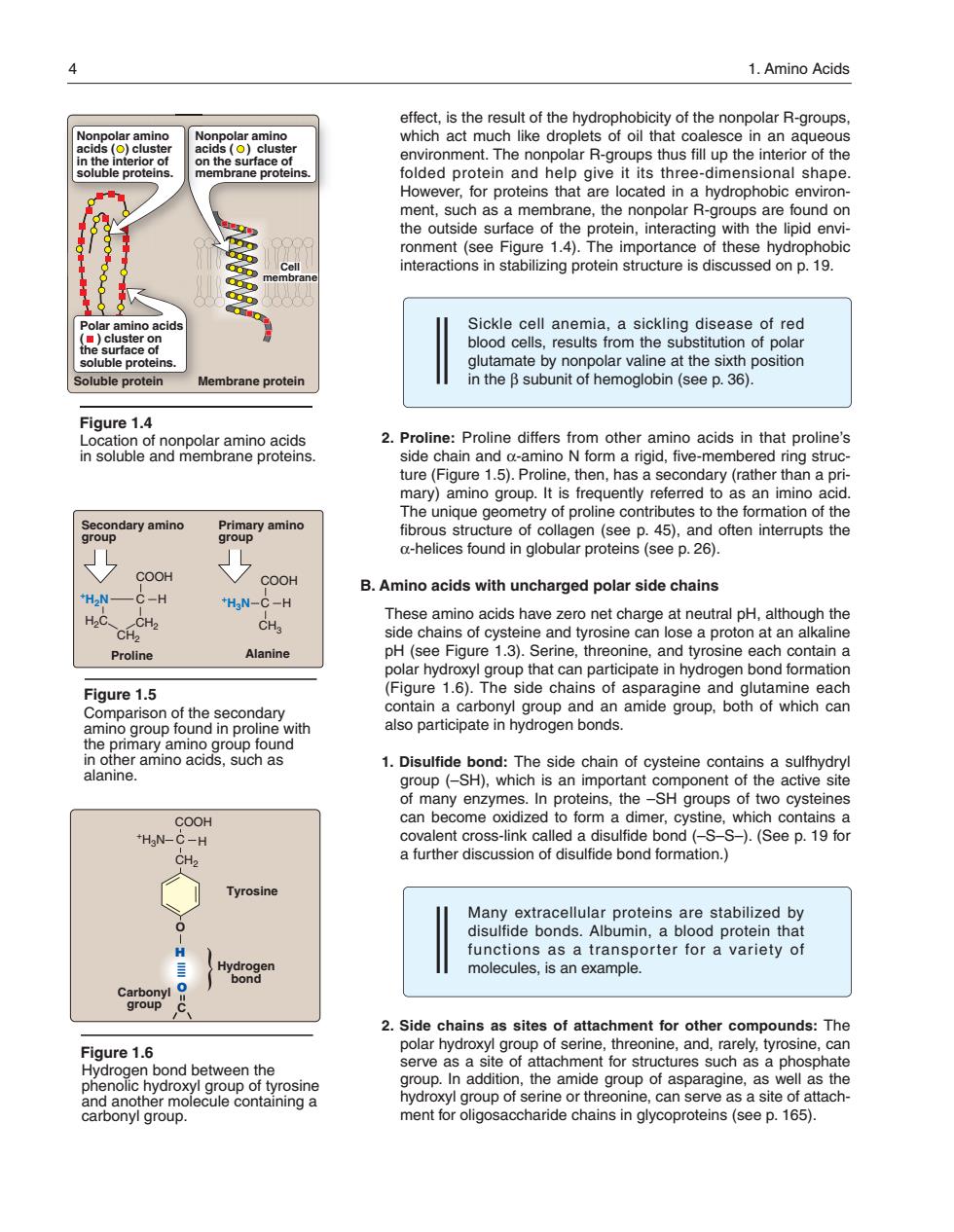正在加载图片...

1.Amino Acids effect,is the result of the hydrophobicity of the nonpolar R-groups. rups thus hterr ot The Howe ment,such as a membrane,the nonpolar R-groups are found on the outside surface of the protein. pia env interactions in structure is discussed on p.19. mino acid Sickle cell anemia nbrane protein in the B subunit of hemoglobin (see p.36). Figure 1.4 2.Pi:rh amino acids in that proline' mary)amino group.It is frequently referred to as an imino acid dary amino The unique geometry of proline contributes to th 0026. COOH OOH B.Amino acids with uncharged polar side chains -C-H HjN- CH Proline Alanine pH(see Figure 1.3).Serine,threonine,and tyrosine each contain a polar hydroxyl group that can participate in hydrogen bond formatior Figure 1.5 (Figure 1.6 Comparison of the secondary of ine also participate in hydrogn bonds. COOH can become oxidized to form a dimer,cystine,which contains a 'HN-C-H bond (-S-S-).(See p.19 for Tyrosine Many extracellular proteins are stabilized by disulfide bonds.Albumin,a blood protein tha unctions as a transporter for a variety of 2.Side chains as sites of attachment for other compounds:The ure 1.6 polar hydr onine.and.rare oond between the group.In addition,the amide group of asparagine,as well a s the cermeorhreonine.canse ande cnains in glycoprote ins as ee p. 165 effect, is the result of the hydro phobicity of the nonpolar R-groups, which act much like droplets of oil that coalesce in an aqueous environment. The nonpolar R-groups thus fill up the interior of the folded protein and help give it its three-dimensional shape. However, for proteins that are located in a hydrophobic environment, such as a membrane, the nonpolar R-groups are found on the outside surface of the protein, interacting with the lipid environment (see Figure 1.4). The importance of these hydrophobic interactions in stabilizing protein structure is discussed on p. 19. Sickle cell anemia, a sickling disease of red blood cells, results from the substitution of polar glutamate by nonpolar valine at the sixth position in the β subunit of hemoglobin (see p. 36). 2. Proline: Proline differs from other amino acids in that proline’s side chain and α-amino N form a rigid, five-membered ring structure (Figure 1.5). Proline, then, has a secondary (rather than a primary) amino group. It is frequently referred to as an imino acid. The unique geometry of proline contributes to the formation of the fibrous structure of collagen (see p. 45), and often interrupts the α-helices found in globular proteins (see p. 26). B. Amino acids with uncharged polar side chains These amino acids have zero net charge at neutral pH, although the side chains of cysteine and tyrosine can lose a proton at an alkaline pH (see Figure 1.3). Serine, threonine, and tyrosine each contain a polar hydroxyl group that can participate in hydrogen bond formation (Figure 1.6). The side chains of asparagine and glutamine each contain a carbonyl group and an amide group, both of which can also participate in hydrogen bonds. 1. Disulfide bond: The side chain of cysteine contains a sulf hydryl group (–SH), which is an important component of the active site of many enzymes. In proteins, the –SH groups of two cysteines can become oxidized to form a dimer, cystine, which contains a covalent cross-link called a disulfide bond (–S–S–). (See p. 19 for a further discussion of disulfide bond formation.) Many extracellular proteins are stabilized by disulfide bonds. Albumin, a blood protein that functions as a transporter for a variety of molecules, is an example. 2. Side chains as sites of attachment for other compounds: The polar hydroxyl group of serine, threonine, and, rarely, tyrosine, can serve as a site of attachment for structures such as a phosphate group. In addition, the amide group of asparagine, as well as the hydroxyl group of serine or threonine, can serve as a site of attachment for oligosaccharide chains in glycoproteins (see p. 165). Figure 1.6 Hydrogen bond between the phenolic hydroxyl group of tyrosine and another molecule containing a carbonyl group. C +H3N COOH CH2 Tyrosine Hydrogen bond O C O H H Carbonyl group 4 1. Amino Acids Figure 1.4 Location of nonpolar amino acids in soluble and membrane proteins. Cell membrane Polar amino acids ( ) cluster on the surface of soluble proteins. Cell Nonpolar amino acids ( ) cluster on the surface of membrane proteins. Nonpolar amino acids ( ) cluster in the interior of soluble proteins. Soluble protein Membrane protein Figure 1.5 Comparison of the secondary amino group found in proline with the primary amino group found in other amino acids, such as alanine. C +H3N COOH H CH3 Alanine COOH H Proline C CH2 +H2N H2C Primary amino group Secondary amino group CH2 168397_P001-012.qxd7.0:02 Protein structure 5-20-04 2010.4.4 9:45 AM Page 4